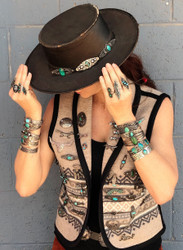Collector’s Corner Handmade Vs. Hand Assembled
Posted by Jim Olson on Nov 2nd 2020
Why is it important to know the difference between handmade and hand-assembled (or hand-crafted)? Value! The differences can sometimes be slight, but it’s worth knowing if you want to be an informed collector.
As savvy collectors, we anticipate the items we collect will appreciate over time, or at the very least, retain their value. Sometimes that can be difficult to predict with market changes and what-not, but one of the things we can do to help sway chances in our favor, is to collect better stuff.
An example is the so-called Fred Harvey era jewelry. We know this refers to turquoise and silver items (mostly jewelry) made in the first half of the 20th century. In recent years, Fred Harvey era items have been very popular with collectors. However, there are some (bracelets for example) from that time period which sell in the $100 to $200 range, while others may sell for $1,000 and up. The difference—the higher value ones are completely handmade and discerning collectors know the difference. Which do you rather grandma have bought back in the day? The ones now worth $100 or the ones now worth $1,000 or more?
So what constitutes “handmade?” A definition found in the in the Google Dictionary says: handmade (adjective) made by hand, not by machine and typically therefore of superior quality. Hand-wrought and hand-forged are synonyms. Basically, it means the artist or maker made the item from scratch and did not buy precast parts and assemble them together. Hand-assembled or handcrafted items generally consist of items put together from two or more pre-made or precast pieces (most of the time precasting is done by machine or in mass-produced methods). As a matter of disclosure, very, very few things are completely handmade anymore, but the closer you can get to being purely handmade, the better off you are.
For example, you can have a pair of spurs using precast spur blanks cast in a factory somewhere or you can make a pair of spurs by forging them from a single piece of steel. You can have belt buckles made using precast buckle blanks bought from a supplier or you can hand forge them from silver (or other metals). You can have a turquoise bracelet made from a bracelet blank (bought at the jewelry supply store) or you can start with ingots of silver and create it yourself. All of the above can then be decorated with precast silver, gold or other non-precious embellishments, or the artist can cut the embellishments out by hand or even hand engrave the items.
As a collector, it is important to know the difference between completely handmade and the various stages of hand-assembled for yourself. Do not take anyone’s word for it unless you know the person knows what they are talking about and you trust that person’s judgement. A lot of items will be presented to you as “Handmade” when in fact they are mostly hand-assembled. To some, that is a small difference and they may think we are splitting hairs, but down the road, it will most definitely make a difference in value when you present those items to the collector marketplace for resale.
Just know this, if the item you are buying was assembled using parts the artist purchased at the store, it is NOT completely handmade. Sure, it may have a good look to it and may be hard to tell at a glance the difference from a completely handmade item, but you will most assuredly realize the difference when you want to resell (if your buyer is a knowledgeable collector).
In the realm of so-called handmade items, there is a big difference between a true craftsman who can take raw materials and build a piece of art from scratch vs. the person who, although they may have an artistic eye, are merely assembling pieces together and saying it is handmade. And the advanced collectors know the difference.
One of the best ways to describe it I can think of is a paint by numbers piece of art. If you have a piece of art whereby the “artist” sat down with a paint by numbers kit and it told them where to paint and what colors went where and they were basically just filling in some blanks, you could argue (weakly in my opinion) that it is hand painted. However a paint by numbers artwork will never be valued in the collectors world in the same way a piece of art is where the artist sat down with a blank canvas and painted a wonderful scene from the imagination using an image in their head or perhaps a photo.
What’s worse than not even being hand-assembled however, is if a piece is completely machine made. With technology the way it is today, they can mass produce items which to the untrained eye look like the real deal. My advice is to avoid those types of items completely as they are almost never “collectible” in the long run. Hand-assembled is much better than machine made, but the purist prefers as close to completely handmade as possible. If you are not sure how to tell the difference, start talking to reputable dealers and collectors who can show you the little tell-tale signs.
So the next time you see a belt buckle that was made using a buckle blank and then had precast embellishments applied to it, or perhaps a bracelet made in a similar manner, think of the difference between a paint by numbers piece of art vs. a truly hand drawn, hand painted masterpiece. Both may have a good look to them, but when you go to sell the items in the market of collectibles, there will be a big difference in price.
Of course, you will likely have to pay more for the completely handmade item in the beginning, but you are a lot more likely to see appreciation, or at least have it hold its value, when you buy handmade over hand-assembled.
Jim Olson © 2020

